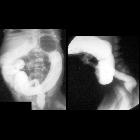Smith-Lemli-Opitz-Syndrom
Smith-Lemli-Opitz syndrome (SLOS) also known as 7-dehydrocholesterol reductase deficiency is an inborn error of cholesterol synthesis.
Epidemiology
The estimated incidence is at 1:20000-40000 live births. Prevalence may be greater in Nordic countries.
Clinical presentation
There are many which include:
- CNS
- intellectual disability
- hyperexcitability
- microcephaly
- hypotonia
- holoprosencephaly
- craniofacial
- blepharophimosis
- epicanthus
- micrognathia
- low set ears
- limb
- postaxial polydactyly
- syndactyly: usually 2 and 3 toes
- congenital cardiac anomalies
- congenital urogenital anomalies
- intra-uterine growth restriction (IUGR)
Pathology
The condition often results from a mutation in the DHCR7 gene on chromosome 11q12-13 which reduces the activity of 7-dehydrocholesterol reductase. Rarely there may be a mutation in chromosome 7q32.1. There is then a lack of cholesterol production as well as a build-up of potentially toxic by-products of cholesterol production which accumulate in the blood and other tissues. It was traditionally classified into 2 types although they are not considered to represent the spectrum differing severity.
Genetics
It carries an autosomal recessive inheritance .
Associations
Markers
- low maternal low estriol : although nonspecific
Radiographic features
Antenatal ultrasound
There may be increased nuchal translucency in 1trimester as an early feature . Antenatal ultrasound may also be able to detect some of the above clinical features.
Treatment and prognosis
The syndrome carries a poor prognosis with most infants not surviving soon after birth.
Siehe auch:
- Polydaktylie
- Kryptorchismus
- nuchal translucency
- Morbus Hirschsprung
- Mikrognathie
- Syndaktylie
- Mikrozephalie
- Intrauterine Wachstumsretardierung
- Hypospadie
- low set ears
und weiter:

 Assoziationen und Differentialdiagnosen zu Smith-Lemli-Opitz-Syndrom:
Assoziationen und Differentialdiagnosen zu Smith-Lemli-Opitz-Syndrom:






